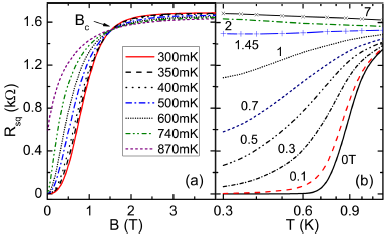Superconductor-insulator transition
The reduction of the thickness of superconducting films, d, increases the disorder and leads eventually to the thickness-induced superconductor–insulator transition (d-SIT). The transition to the insulating phase may be also induced by the presence of external magnetic field B (B-SIT). This evolution remains one of the most important and perplexing problems in condensed matter physics. It has been suggested recently that various materials may be divided into two groups depending on the behavior of the resistance in the vicinity of the SIT [1]. The first group are the strongly disordered systems with small carrier concentration, n, such as InOx or TiN, in which the resistance rises exponentially with lowering of the temperature, T, and huge magnetoresistance peak is observed on the insulating side of the B-SIT. The second group includes materials with large n and small disorder, such as, for example, MoGe, Bi, PbBi or Nb1-xSix. In these systems the resistance grows only logarithmically with the decreasing temperature and the magnetoresistance increase in the B-SIT is rather modest. Recent theories predict that different B-SIT appears in these two groups. While the uniform suppression of the superconducting order parameter with increasing B is believed to occur in weakly disordered systems with large n, the presence of superconducting islands immersed in the insulating matrix is expected in the strongly disordered materials with small n.
Recently the d-SIT has been studied in our laboratory in two different materials. One of them is conventional superconductor, niobium [1]. The Nb films, of thickness d from 50 nm down to 1 nm, are sandwiched between two silicon cover layers to prevent oxidation. We have observed the change of sign of the Hall coefficient (RH) from positive in the thick films, to negative in the ultrathin limit. The films become amorphous for d < 3.3 nm, and the RH gradually evolves into negative for d < 1.6 nm. The effect is most likely caused by enhanced carrier scattering in the amorphous films. This observation, never reported before, is of relevance for the understanding of the disappearance of superconductivity in the ultrathin film limit. It is also important for potential applications, since Nb films are frequently used in the design of novel devices. The detail study of the magnetoresistance in the trilayers with different Nb thickness reveals that the suppression of superconductivity by the magnetic field leads to the strongly disordered metallic phase, not to insulating phase [2].

Transmission electron microscopy image of Si/Nb/Si trilayer, with Nb thickness of 1.2 nm.

Resistance of Nb film with d = 1.3 nm as a function of magnetic field B for fixed temperatures (a), and as a function of temperature for fixed B (b).
In the magnetic field range 0.1 T < B < 1.45 T the resistance in the T=0 limit saturates at finite level, different from normal-state resistance, suggesting the existance of metallic, non-superconducting state.
The other material which is studied is high-temperature superconductor, LSCO [3]. The study of the transport properties of strained La2−xSrxCuO4 films (x = 0.048, x = 0.051), deposited by laser ablation from insulating targets, shows that strong compressive strain induces superconductivity. The superconductivity appears with the reduction of the film thickness, when the substrate-induced compressive strain is enhanced. This thickness-induced insulator-to-superconductor transition is in stark contrast to the thickness-induced destruction of superconductivity observed in niobium films; such behavior so far has not been described in the literature. The superconductivity in the strained films is accompanied by very small, but finite, residual resistance, which is present even in the absence of the magnetic field, and which increases with the enhancement of strain. The finite resistance is most likely caused by strong inhomogeneity of the strained films, which are likely to contain small nonsuperconducting areas within the sample volume.
[1] Negative Hall coefficient of ultrathin niobium in Si/Nb/Si trilayers, I. Zaytseva, O. Abal’oshev, P. Dłużewski, W. Paszkowicz, L. Y. Zhu, C. L. Chien, M. Kończykowski, and M. Z. Cieplak, Phys. Rev. B 90, 060505(R) (2014).
[2] Ultrathin Niobium in the Si/Nb/Si Trilayers, I. Zaytsevaa, O. Abal'oshev, P. Dłużewski, R. Minikayev, M.Z. Cieplak, L.Y. Zhu and C.L. Chien, Acta Phys. Pol. A 126, 140 (2014).
[3] Superconductor-insulator transition in selected films of conventional and high temperature superconductors (in polish), Iryna Zaytseva, PhD thesis, 2015.
